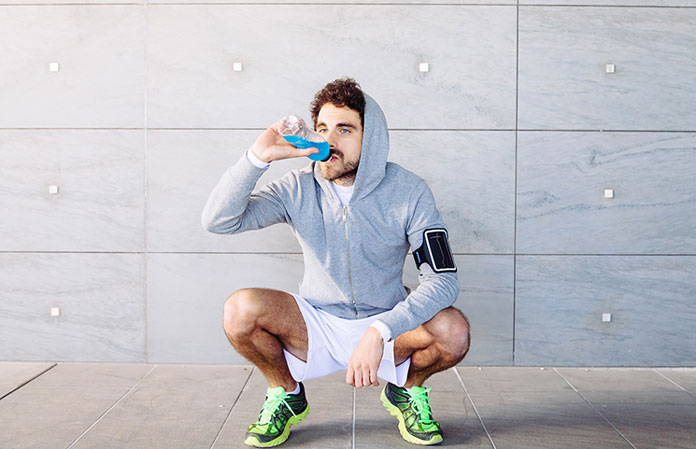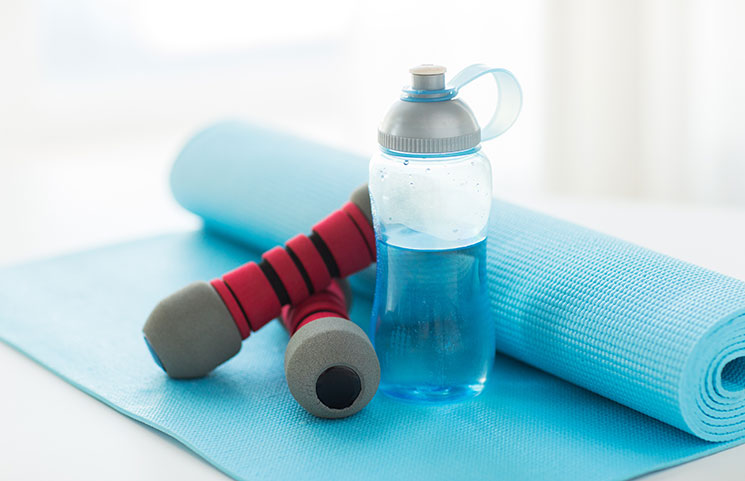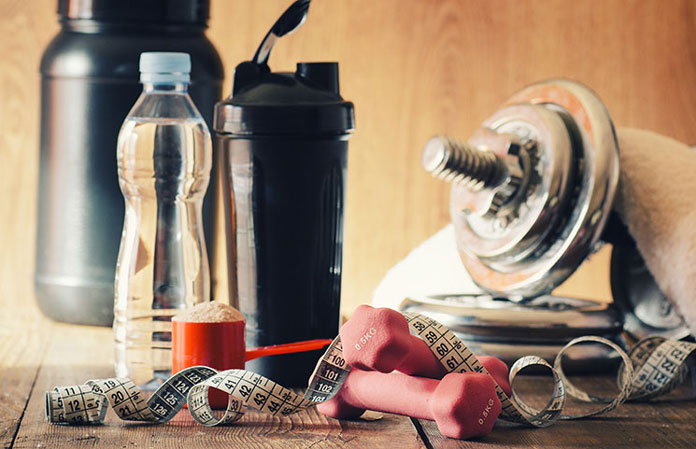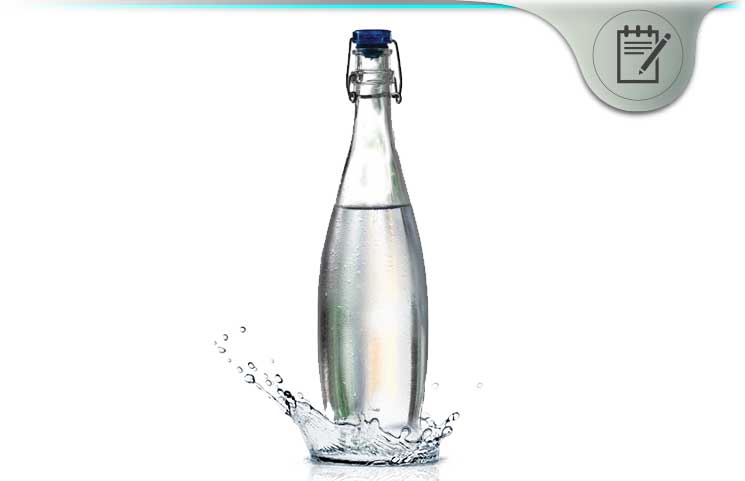Convenience is the sole reason why plastic bottled water was invented. Think about it, you are going for your morning jog, run, or walk, and you don’t have access to bottled water. Sure, you could fill some sort of a glass or ceramic container and lug it around with you. But not only is that unsafe, it’s also a huge pain in the butt.
Originally, bottled water was first introduced to consumers around 1767 by Jackson’s Spa. The mineral spring water was thought to be capable of healing all sorts of ailments when drunk or bathed in. Obviously, you can’t visit the spa every day, and having the option to take a few bottles of this borderline miracle water with you back to your home was extremely convenient. Needless to say, the bottled water was a success.
Plastic water bottles are a whole different story. They were first invented around 1947 for commercial use. However, back then plastic was somewhat expensive and it wasn’t until the 1960s when high density polyethylene was used that plastic bottles gained quick reputation and became widely used by everyone.
One of the main reasons for using plastic bottles over traditional glass bottles was because of the difference in weight; plastic is far lighter than glass. This weight difference made it a lot more affordable to transport goods that could be placed into plastic bottles across the country.
Additionally, and perhaps the most important reason why plastic bottles have replaced nearly all glass bottles, they don’t break nearly as easily as glass bottles. This means your product is safer during transportation and you don’t have to spend additional money to ensure that bottles don’t break when being moved. Today, besides wine and beer, nearly all glass bottles in the food industry have been replaced with plastic bottles.
The plastic water bottle revolution was in full swing. The convenience factor of using the lightweight, nearly unbreakable water bottles was simply too high. Furthermore, concerns about diseases that stem from natural water sources ensured that many Americans continued drinking the much safer treated bottled water.
It wasn’t until the early 20th century that the popularity of water bottles decreased due to the invention of water chlorination, which was used on municipal water supplies.
Consumers felt more relaxed about drinking the now treated water from municipal sources and less afraid of water-borne diseases that were previously a threat. However, in 1977, the ever-famous company Perrier launched a campaign designed to rebirth the use of bottled water in the United States. The campaign was a success and bottled water quickly became the second most popular commercial beverage in the United States.

Today our supermarkets are saturated with bottled water. There are hundreds of different water bottle brands to choose from and more are being created every day. Making a choice can quickly become a headache. The labeling laws in the United States are far too lax and making a decision by simply reading the bottle label isn’t a viable option. Fortunately, we are here to help.
We have looked at some of the bottled water products available for purchase at most local grocery stores and compared them to each other. The top most popular brands of bottled water were chosen, namely JUST Water, Nestle Pure Life, Volvic, VOSS, Penta, Resource, Evian, Fiji, Acqua Panna, Aquafina, Dasani, and Crystal Geyser.
There are three different factors that were taken into account when looking at each bottled water brand: pH level, taste, and packaging. Let’s us explain in more detail how we used each one of these factors.
pH Balance
Without any additional chemicals, natural water has a pH balance of about 7. This number can vary slightly but no more than a few tenths of a point. This balance is determined by the effect that pH levels in drinks have on your system.
Drinking highly acidic liquids isn’t a very good idea if you are planning on consuming them daily and frequently. Imagine giving your teeth a constant acid bath, and this is exactly what happens when you drink water or soda that has a low pH level.
At the same time, water or beverages that have high pH levels are often advertised as alkaline products and said to have health benefits when consumed. The problem is that there isn’t enough research that has been done to determine the exact effects of alkaline water on our system.
In fact, some doctors stipulate that high pH water can have a negative effect on your esophagus and cause frequent irritations and further complications. So, while high pH drinks are most likely okay to be consumed infrequently, constantly drinking them is not a good idea and thus all bottled water products that had abnormally high pH levels were omitted from our top brands list.
Only waters that had a pH level between 6 and 8 were accepted as top contenders for daily consumption. Special pH tests were conducted to ensure an accurate and unbiased reading of pH levels in each brand.

One would assume that water which is being sold for constant consumption in our local supermarkets would indeed have neutral pH levels equivalent to natural water. We thought so too, but unfortunately out of the 13 brands that were tested quite a few had pH levels that were not acceptable. VOSS, Penta, Aquafina, and Dasani all had a shocking pH level of 4.
To put it into perspective, that is the same acidity level as most commonly sold sodas, which range between 3 and 4 pH. In other words, if you are frequently drinking one of these water products, you are essentially giving your teeth a bath with something a bit less acidic then a can of Cola.
Alkalinity wasn’t as much of a concern as acidity. The only brand which was more alkaline then most frequent drinkers should consume was Acqua Panna with pH level of 8.5. This level is slightly higher than we would like to see but not nearly as shocking as the levels we observed in previously mentioned brands.
The Taste Test
Taste is a very subjective sense. We each have our own reason for why we like the way something tastes. Although it seems that when talking about pure water, we all look for a very similar taste.
There were 12 testers who did the taste test on the brands of bottle water that were chosen to be evaluated. Each of them were trained by Arthur von Weisenberger, an expert in all thing related to bottled water who has been running a well-known Bottled Water Web site. Arthur was kind enough to share the testing guidelines which he used to train judges for the annual Berkeley Springs International Water Tasting.
The testers were taught to observe the following key elements of each brand of water: odor, flavor, aftertaste, appearance, texture, and overall impression. Water was given to each tester at room temperature in identical and unmarked cups. The results were very promising.
The testers were able to quickly identify which brands were not liked by anyone and which ones were closer grouped taste-wise and more difficult to separate in quality. One thing was certain; Dasani was disliked by more than half of the testers who placed it among the bottom three brands. The taste of this specific bottled water was described as metallic and somehow plastic like. Some individuals simply stated that the water tasted weird.
It did seem that bottled water brands with a neutral pH level were liked by most of the testers. However, the clearest factor that separated the brands from each other was the sources of each brand of water. The three top picked brands were all spring water, while the two least favored brands came from municipal water sources, which is pretty much the bottled water equivalent to tap water.

Container Test
Most of the plastic containers used today for bottled water are made from a PET type of plastic which is considered to be lightweight, generally safe, and cheap to produce. However, even though nearly all of the brands that were tested have similar bottles, some of the containers definitely stood out more than others, for good and bad reasons.
Most of the testers did not like the traditional cylindrical bottles that we come across in our supermarkets, which are often ridged for whatever reason. We didn’t think it was possible to create a container that was less appealing than this standard shape, but Glacier Clear was determined to prove us wrong. Before the bottles were even handled, crumbling and loss of shape could be observed in these bottles.
The problem is that Glacier Clear decided to use an ultra-lightweight plastic which is much cheaper to produce. At the same time, because the plastic is so thin, bottles quickly lose their shape and are often unpacked with preexisting dents and deformations. This was easily one of the least appealing bottles designs ever manufactured.
The rest of the brands didn’t have anything special about their containers. Although, JUST Water, one of the only brands that did not use plastic for their container, did have an interesting paper carton designed which was coated to prevent slippage. At first most of the testers seemed somewhat skeptical of the packaging, but ultimately most of them were pleased with the creative idea.
The Top Bottled Water Picks
1. Resource Spring Water
Immediately after the taste test it was clear that Resource was going to be one of the most liked bottled waters. Testers described the water as crisp, refreshing, and smooth, which is a clear opposite of the brands at the bottom of list which were labeled as stale and metallic.

One clear reason why this brand of water tastes so good is because of the natural electrolytes that are claimed to be present in the water by Nestle. This shouldn’t make you think that Resource is similar to the advertised post workout waters like Propel. Resource has a mid-range level of electrolytes in it with about 5.5 siemens per meter.
These electrolytes are part of the waters Total Dissolved Solids level, known as TDS, which greatly affects the taste of the liquid. It’s natural to think that one would rather drink water with as few dissolved solids in it as possible, but the truth is a bit more complicated than that.
While it is true that high TDS levels in water will give it a very strong taste and most people won’t like it, the opposite will have a somewhat similar effect but without taste at all. Water with extremely low TDS levels is effectively simply distilled water. and if you have ever drank distilled water you know that its taste can be described as bland and flat.
Resource is able to get the levels of electrolytes and TDS just perfect, which is combined with the very close to perfect pH neutrality of 7.5. The result is pH balanced water with perfectly balanced TDS to make it taste just right.
Additionally, the brand decided to only produce the water in quart sized bottles, which slightly reduces the impact on the environment while keeping you hydrated throughout the day. But nothing is perfect and even this fantastic bottled water has its small, and to some easily overlooked, drawback.
Unfortunately, the caps on the bottles of Resource water are somewhat small and feel a bit thin. While this shouldn’t be an issue for most people, losing these caps can be frustrating for those of us who are on the run. The price of Resource water is about $38 per 12 pack of quart sized bottles which roughly adds up to about 9 cents per ounce.
2. Fiji
We all know of the brand known as Fiji, with their easily identifiable bottle design. Unlike Resource, Fiji is a well-known brand that can be spotted in many different locations, often sold in coffee shops and little eateries. The brand is very well advertised and frequently boasts about its superior quality and taste.
Nearly half of the testers ranked Fiji among their top three picks, second only to Resource. The words used to describe Fiji were revitalizing and soft without any odor or aftertaste. The primary reason why Fiji was ranked slightly lower than Resource is because Fiji has a slightly higher electrolytes content and is a bit more alkaline then Resource.
The be clear, the electrolytes levels aren’t crazy and out of control, they are well balance just slightly higher than those of Resource water, and the same can be said about pH levels. Fiji is still a very good choice for daily frequent consumption and some of you might prefer its taste over Resource.
Unlike resource, Fiji does have a few different sized bottles to offer. The most commonly bought size is the 16.9-ounce bottle which will cost you about $20 for a 24 pack. So, while the taste is slightly less pleasing then the bottled water at the top of our ranks, 5 cents per ounce is a huge dropdown from 9 cents per ounce at nearly half the price. If you are looking for water that is high quality but don’t want to stretch your wallet as far, then Fiji is definitely a good choice.
Oh, and don’t forget that the Fiji bottle is shaped like a prism, so you will certainly stand out amongst all the other water drinkers out there. The downside to this is that you can forget about using cup holders, the 16.9 ounce bottle isn’t going to fit in there. Your only choice is to buy the 11.15 ounce sized bottles which are also somewhat pricier per ounce.

3. Crystal Geyser
Finding Resource or Fiji at your local gas station might be a bit of a challenge. But what does one do when all you can see are Dasani, Aquafina, and Arrowhead? Must your teeth suffer and get ready for the acid bath? Well, not exactly. There is a brand of bottled water that can be found in most delis, gas stations, and little corner grocery stores, and it’s called Crystal Geyser.
Unlike the three brands we listed in the above paragraph, Crystal Geyser is not only much more affordable than our top two choices but it is also pretty reasonably balanced when it comes to pH and electrolyte levels. Although some of the testers did deem Crystal Geyser a bit mineral heavy and somewhat chemical like, most didn’t have any issues with the way it tasted. Some said that the water was refreshing and crisp, which is a pretty surprising feat considering that this bottled water is priced at nearly half of Fiji and one third of Resource.
Another somewhat pleasing feature about Crystal Geyser is that their water bottles don’t have crazy shapes to them, they are all rather standard. This means your cup holders can resigned from being coin banks and once again hold on to what they were designed for, drinks, such as bottled water.
The downside to these standard shapes is that Crystal Geyser decided to use a somewhat flimsy plastic variant in their bottles, with a pretty cheap looking cap on it. The good news is that there are huge amounts of this brand bottled water available, so buying it in large quantities for weddings or big parties shouldn’t be an issue. And because the price is pretty low you won’t have to empty your bank account to keep a few people hydrated.
The standard sized bottles of Crystal Geyser come in 16.9 ounces and will cost you about $20 for a 35 pack, effectively making it one of the cheapest, yet still pretty well-balanced, choices for bottled water at around 3 cents for every ounce.
On honorable mention, which is a good alternative for our number 3 spot bottled water in case you can’t find Crystal Geyser at your local store, is Nestle Pure Life. The brand is pretty close in price and is nearly identically balanced as Crystal Geyser.
4. JUST Water
Contradictory to its name, JUST Water is much more than just water. To be honest, the water might be but the bottles it’s in is definitely no ordinary bottle. The JUST Water brand is actively targeting consumers who want to stay away from plastic. Backed by celebrities like Queen Latifah and Will Smith, JUST Water quickly gained footing among the bottled water brands.
They container is made out of coated paper which is one hundred percent recyclable. Technically, it does contain a small amount of plastic in it to help keep the shape of the container, but this specific type of plastic is plant based instead of petroleum based which makes it harmless.
An unexpected side effect of the materials used in the carton is the texture and less slippery surface which is very comfortable to the touch. So, the chances of your bottle slipping and falling during those hot summer days, when cold water creates condensation on the outside, are pretty much nonexistent.
So, the bottle is pretty awesome but what about the taste? Well, it’s not bad but it isn’t on the Resource and Fiji level. Testers have said that JUST Water is refreshing with a slightly mineral heavy sub tone. This brand of water is slightly alkaline, similar to Fiji, but the electrolyte levels are closer to Resource at around 3.9 siemens per meter.
In general, this slightly imbalanced electrolyte level and pH level is the reason why JUST Water wasn’t rated higher. Although, the creativity and low environmental impact definitely makes up for its other shortcomings.
And now let’s talk about the price. There is a reason why some companies are able to produce a much better-balanced product and keep the costs down; it’s usually due to the quality of plastic being used in the bottles. Because JUST Water decided to focus on making a zero-impact bottle, their price is much higher than other brands which are in the same league.
JUST Water comes in pint sized bottles and a 12 pack will cost you $21, which is equal to 10 cents per ounce. This price can be slightly cheaper if you order directly from the JUST Water website through a subscription method. This is the most expensive water on our list, but if you care about drinking out of a plastic free bottle and reducing your footprint on the environment, then JUST water is a great choice.

5. Other Brands
There are a couple of brands that we ran into with surprising results, specifically, Volvic and Evian. These brands are based out of Europe and while the testers agreed that their bottle shapes were simple yet elegant, not all of them agreed on the taste. More than half of the testers placed both of these brands in their bottom three bottled water rankings, stating that the water was somewhat musty and stale.
However, at the same time a few of the testers had the opposite response and said that these brands tasted refreshing and even sweet. Those who didn’t like the brand had nothing positive to say about it, while those who did like the brand absolutely loved it.
We think that the main reason why there is such a big difference in likability among European waters is because the tastes which are favored in Europe aren’t necessarily well like by those who reside in the United States, and vice versa. Our suggestion is to simply try the water offered by these brands and if you like the way it tastes then go ahead and continue drinking it.
Bottled Water Final Words
We want you to keep in mind that, as we mentioned earlier, taste is subjective. Some of you might not find our top picks to be the best tasting water you have ever had and some will agree 100%. The only way for you to determine the right bottled water is by trying them.
With that said, there clearly are some brands that we looked at which should not be consumed or should be consumed at your own risk. We are talking about those brands that have extremely acidic waters or highly alkaline waters. Drinking these brands once in a while is okay and might even be beneficial for your body, but drinking them constantly to keep yourself hydrated is certainly going to produce negative effects. We strongly urge you to stay away from highly imbalanced waters; it’s a much better decision in the long run.
Lastly, we should mention a few things about PET, short for polyethylene terephthalate. This plastic is extremely lightweight and it helps most of the brands reduce their carbon footprint. Additionally, it is also fully recyclable. However, there are some studies that point to a potential health risk when PET is exposed to high temperatures.
Speculations are that when PET is exposed to temperatures over 100 Fo it is capable of releasing endocrine disruptors into the water inside the bottle, which causes the water to exceed the allowed limits suggested by the EPA.
While the majority of the brands out there claim that the release of endocrine disruptors into the water isn’t possible and is simply not true, we think it is best not to risk it. If you live in particularly hot environments, don’t leave your water out in direct sunlight. Alternatively, you could also give JUST Water a try, but remember, you will be paying for it.









